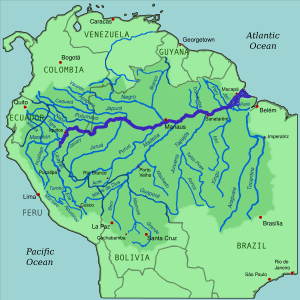Why the Amazon forests are no longer acting as a carbon sink
Why in the news?
- A recent study published in the Journal Nature, shows that the Amazon forests in South America, which are the largest tropical forests in the world, have started emitting carbon dioxide (CO2) instead of absorbing carbon emissions.
The Amazon basin
- The Amazon basin is huge with an area covering over 6 million square kilometres, it is nearly twice the size of India.
- The Amazon rainforests cover about 80 percent of the basin and as per NASA’s Earth observatory, they are home to nearly a fifth of the world’s land species and is also home to about 30 million people including hundreds of indigenous groups and several isolated tribes.
- Other than this, the basin produces about 20 percent of the world’s flow of freshwater into the oceans. Over the last few years, the forest has been under threat due to deforestation and burning.
- Forest fires, according to Brazil’s National Institute for Space Research (INPE), have doubled since 2013. One reason that they happen is when farmers burn their land to clear it for the next crop
- Deforestation in the Brazilian Amazon, which comprises about two-thirds of the area of the rainforest, started in the 1970s and 1980s when large-scale forest conversion for cattle ranching and soy cultivation began.
- NASA’s Earth Observatory notes that state policies that encourage economic development, such as railway and road expansion projects have led to “unintentional deforestation” in the Amazon and Central America.

Key takeaways from the study
- Over the years as fossil-fuel emissions across the world have increased, the Amazon forests have absorbed CO2 from the atmosphere, helping to moderate the global climate.
- But because of significant levels of deforestation (over the course of 40 years) there has been a long-term decrease in rainfall and increase in temperatures during the dry season.
- Because of these reasons the eastern Amazon forests are no longer carbon sinks, whereas the more intact and wetter forests in the central and western parts are neither carbon sinks nor are they emitters.
- Another reason for the eastern region not being able to absorb as much CO2 as it did previously is the conversion of forests into agricultural land, which has caused a 17 per cent decrease in the forest cover, an area that is almost the size of continental US.
- In the southeast region, which forms about 20 percent of the Amazon basin and has experienced about 30 percent of the deforestation in the last four decades, scientists have recorded a 25 per cent reduction in precipitation and a temperature increase of at least 2.7 degrees Fahrenheit or 1.5 degrees Celsius during the dry months of August, September and October.
- This means that if the ability of tropical forests to act as carbon sinks is to be maintained, fossil fuel emissions need to be reduced and temperature increases need to be limited as well.
Reference:
Subscribe
Login
0 Comments
